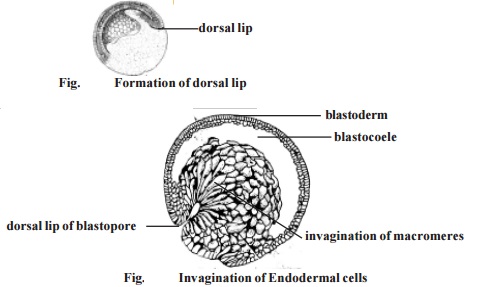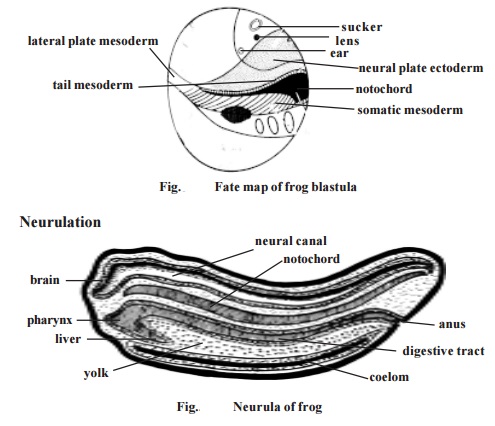Chapter: BIOLOGY (ZOOLOGY) Standard XI first year 11th text book Assignment topics question and answer Explanation Definition
Gastrulation in frog embryo

Gastrulation in frog embryo
The process of gastrulation is a continuous activity succeeding, cleav-age. During this process the blastodermal cells begin to move. They wander and occupy their prospective organ forming zones. During this movement at one region on the blastula, the cells wander inside and occupy the blastocoelic cavity.
At a specific region below the equator the blastoderm cells assume an elongated bottle like shape. They move toward the interior of the blastula. As the cells move further inside, an invagination happens. A deepening of the invagination results in a cavity called the archenteron or gastrocoel.The opening of the archenteron on the surface of the blastula is called the blastopore.
The blastopore gradually assumes a crescentic shape. Finally it be-comes circular. The region dorsal to the blastoporal opening is called the 'dor-sal lip'. The lower edge may be called the ' ventral lip'.
The surface cells representing several prospective zones of the em-bryo begin to wander inside through the blastopore. These inwandering of cells is termed as involution.

Initially, the first pharyngeal endodermal cells undergo invagination over the dorsal blastoporal lip. These cells move to the interior. They are followed by other cells. The inwandering cells gradually occupy the region of the blas-tocoele. Thus the blastocoelic cavity gets reduced. A new cavity among the involuted cells results. It is called the gastrocoel. The gastrocoel later be-comes the archenteron. The interior region of the archenteron gradually trans-forms into the pharyngeal region. This region remains as the foregut. The mesodermal and endodermal cells gradually occupy their positions.
The inward movement of the exterior cells through the blastoporal region is called involution. The involution results in the positioning of chor-damesodermal cells and pharyngeal endodermal cells.
The mesodermal cells occupy the region between inner endodermal and outer ectodermal cells. While the exterior chorda-mesodermal cell invo-lute inside, their place is taken up by the ectoderm. The expansion of the ectoderm is due to epiboly. Epiboly causes overlapping or ' the roofing over' of the gastrula by the ectoderm.
The blastopore is gradually covered by certain endoderm cells. The closing cells of the blastopore constitute the yolk-plug. Gradually the yolk-plug withdraws to the interior and the blastopore gets reduced into a narrow slit.
The process of gastrulation converts the blastula into a spherical, bi-laterally symmetrical, triploblastic gastrula. Gradually the gastrula undergoes the process of tubulation or neurulation to become a neurula.
Neurulation

The process of neurulation is the formation of a neural tube. However during this process mesoderm and endoderm also undergo differentiation.
During neurulation the embryo lengthens along the anteroposterior axis. The dorsal side of the gastrula is lined by ectodermal cells. The presumptive area of the nervous system gets differentiated from the rest of ectoderm. It remains as medullary plate or nerual plate. The neural plate later thickens and it gets raised above the general level as ridges called neural folds. In the middle of the neural fold a neural groove appears. The neural groove deep-ens inside. The neural folds above the groove. The neural groove gets con-verted into a neural tube. This tube gets detached from the surface. The neural tube remains as the prospective nervous system. The embryo at this stage is called the neurula.
During neurulation, the tubulation of chorda-mesoderm and tubulation of endoderm also happen.
The post-neurular development of frog involves the formation of all body organs.
Related Topics